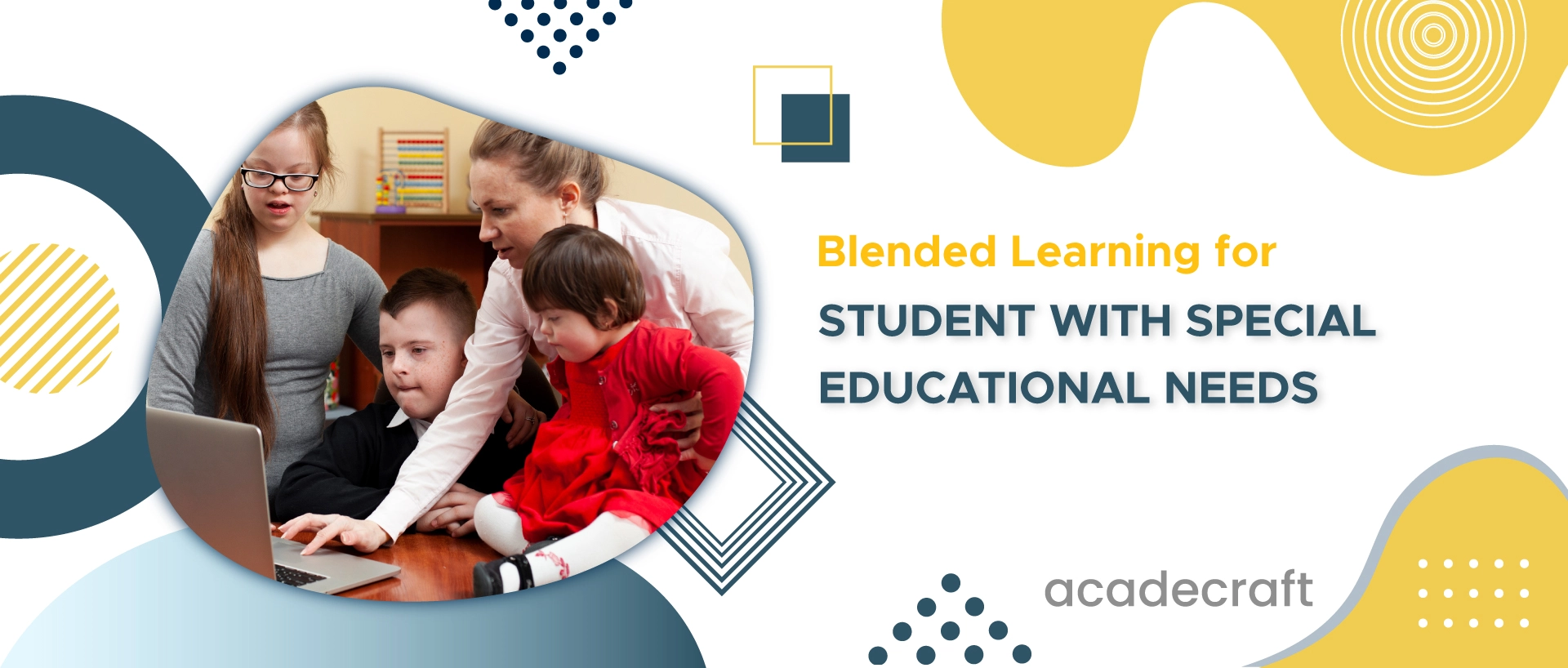
Blended learning is an innovative approach that combines the old and traditional face-to-face instruction with digitized online learning. By incorporating technology into the classroom, blended learning provides students with the helpful resources and tools they need to succeed while accommodating their learning styles and abilities.
The approaches that have gained prominence are the types of blended learning and special education, particularly for students and learners with special educational needs (SEN). Blended learning combines traditional classroom methods with online resources to create a more personalized and effective learning experience. This technique has proven incredibly useful for students with special educational needs, allowing for flexible and personalized learning experiences.
Even businesses can grow and succeed by adopting blended. By offering employees the chance to learn and create new skills through in-person and online training, businesses can ensure that their workforce remains adaptable and competitive in today's rapidly growing market.
The blended learning model refers to the professional teaching method that combines traditional in-person classroom training with online learning platforms. This approach enables educators to tailor the curriculum to meet the unique requirements of students with special educational needs (SEN).
This blended learning model shows that the process begins with a comprehensive assessment of each SEN student's strengths and weaknesses. Based on this assessment, educators create Individualized Learning Plans (ILPs) tailored to each student's needs.
For example, in a blended learning classroom, a teacher may notice that a student with dyslexia struggles with reading comprehension. The teacher can then create an ILP with online reading programs and accommodations such as audiobooks to help students improve their skills.
By blending face-to-face instruction with online resources, the teacher can provide personalized support to enhance the student's learning experience.
The online component of blended learning for students with disabilities offers flexibility. SEN students can access multimedia resources, interactive exercises, and digital textbooks. These resources administer various learning styles and abilities.
For example, a dyslexic student may benefit from using audiobooks to improve their reading skills. In contrast, a visually impaired student can utilize online reading programs that offer customizable font sizes and backgrounds. By providing these accommodations, teachers can ensure that all learners have equal access to educational materials and can learn at their own pace.
Blended learning allows for real-time progress monitoring. Teachers can track students' performance online, identify areas needing additional support, and adjust their ILPs accordingly.
For example, a teacher may notice that a student is struggling with a particular concept in math. Through progress monitoring, the teacher can use online resources to provide additional practice and targeted instruction for that concept. The blended learning model allows the student to receive personalized support and helps them stay on track with their learning goals.
In a study, it has been found that blended classrooms are preferred by 85% of educators as they provide students with a more personalized learning experience.
Blended learning offers various advantages for special education needs students. Let us take note of a few of them that our blended learning solutions can offer :
Each student receives a customized learning experience, addressing their needs and pace. It allows SEN students to work at their level and progress comfortably, ensuring they fully grasp the concepts being taught. Blended learning can be particularly beneficial for visually impaired students as it caters to their unique needs.
They can access learning materials in different formats, such as braille or audio, and use specialized software or devices to enhance their learning experience. The blended learning technique also allows for more flexibility in accessing resources and completing assignments, allowing visually impaired students to participate fully in their education.
SEN students can access learning materials conveniently, accommodating different learning rhythms. This flexibility allows them to take breaks and revisit concepts as necessary, promoting a more comfortable and effective learning environment.
Additionally, blended learning for students with disabilities provides opportunities to engage with multimedia resources and interactive activities, enhancing their understanding and retention of information.

Blended learning incorporates multimedia elements, making complex concepts more accessible through visual and auditory aids. These multimedia resources can include videos, animations, and interactive virtual simulations that address different learning styles and preferences. For example, a visual learner may benefit from watching a video that explains a scientific concept, while an auditory learner may prefer listening to an audio recording of a lecture.
By providing these multimedia resources, the blended learning model allows students to engage with the material in a way that best suits their learning needs. It enhances their understanding of the content and helps them keep the knowledge for longer periods.
Interactive online activities engage SEN students, making learning more enjoyable and interactive. These activities can include games, quizzes, and interactive videos that serve various learning styles and abilities.
For example, SEN students with dyslexia may struggle with traditional reading assignments. Still, by incorporating interactive videos and quizzes into the lesson, they can actively participate, keep themselves engaged in the learning process, and better retain the information.
Here, our online learning solutions can assist you the best. It enhances the student's understanding of the subject matter and boosts their confidence and motivation to learn.
Blended learning empowers SEN students to progress at their own pace, reducing the pressure to keep up with the class. By allowing students to work at their speed, they can take the time they need to fully grasp concepts and reinforce their learning.
For example, in a self-paced learning environment, students with dyslexia can spend more time working on reading and decoding skills without feeling rushed or overwhelmed by the pace of the class.
They can also be free to review and practice concepts until they feel confident in their understanding. It will enhance their overall academic performance and uplift their confidence and motivation to learn.
Teachers, students, and parents can communicate more effectively through online platforms, fostering a collaborative learning environment. Teachers can easily send out announcements, assignments, and feedback to students, ensuring everyone is on the same page and no important information is missed.
Students can also ask their teachers questions or concerns without waiting for the next class period. This improved communication allows for a more holistic approach to education, as everyone can work together toward the student's success.
Implementing blended learning for SEN (Special Educational Needs) students necessitates meticulous planning:
Teachers and educators should undergo thorough professional growth to acquire the skills and knowledge needed to integrate online resources and adapt teaching methods effectively. This training empowers them to create a learning environment that caters to SEN students' diverse and unique needs, ensuring that they receive the best possible support and instruction tailored to their requirements.
For example, a teacher may undergo professional development to learn how to use assistive technology and online resources to support students with visual impairments. This training would enable the teacher to provide accessible materials and adapt teaching methods, such as screen readers or braille displays, to ensure these students can fully participate in the learning process.
It's essential to ensure that all students, including those with special educational needs, have access to the necessary technology and support for online learning. This inclusivity guarantees that no student is left behind and everyone has an equal opportunity to benefit from blended learning.
For example, in a blended learning environment, students with visual impairments can use screen readers and braille displays to access digital materials and participate in online discussions. Accessible technology allows them to fully engage in learning, access information independently, and collaborate with their peers effectively.
Regular and continuous assessment is crucial in the blended learning approach for SEN students. It allows educators to monitor students' progress, identify areas where they may need additional support, and make timely adjustments to their Individualized Learning Plans (ILPs). This dynamic approach ensures that students receive the right guidance and resources as they progress in their learning journey.
For example, in a blended learning classroom for SEN students, ongoing assessment can be conducted through online quizzes and interactive activities. These assessments can provide students with rapid feedback, enabling them to track their progress and identify areas where they may need extra help. Additionally, educators can use this data to personalize instruction and provide targeted interventions to support students' needs.
Engaging parents actively in the learning process is vital. Providing parents with the tools, information, and strategies to support their children's education at home fosters a collaborative learning environment.
When parents and educators work together, it enhances the overall educational experience for SEN students. It creates a unified support system that extends beyond the classroom, contributing to the success and well-being of these students.
By actively involving parents in their children's education, the school creates a strong partnership between parents and educators, ultimately leading to improved academic outcomes for SEN students.
Incorporating online resources for students and training modules for employees can help learners with SEN to access a variety of multimedia content that caters to their specific learning styles. For example, visual learners can benefit from interactive videos and graphics, while auditory learners can engage with audio recordings and podcasts.
Blended learning and special education allow learners to work at their own pace, allowing them to revisit and review material as needed. Hence, it offers a flexible and inclusive approach that supports the diverse needs of students with special educational needs.
Share